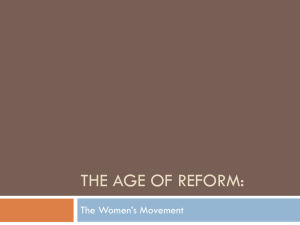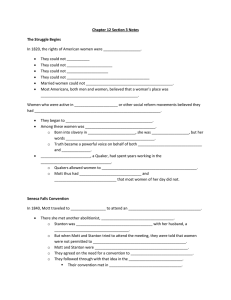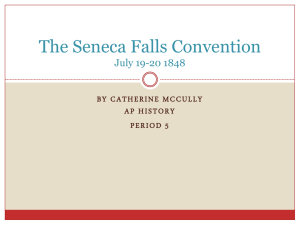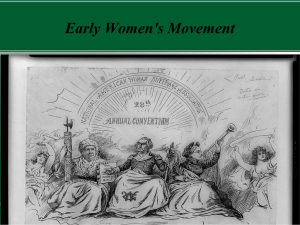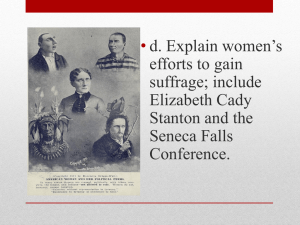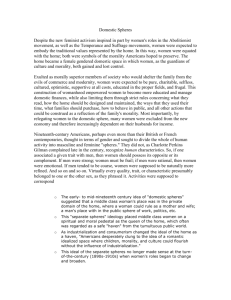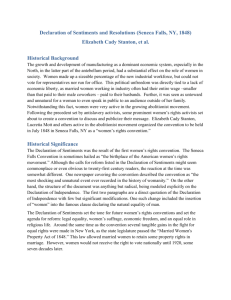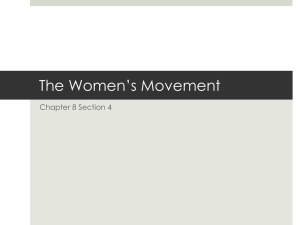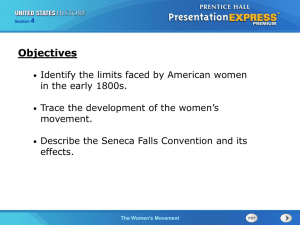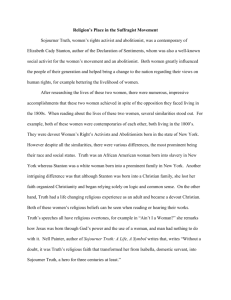A Call for Women`s Rights
advertisement
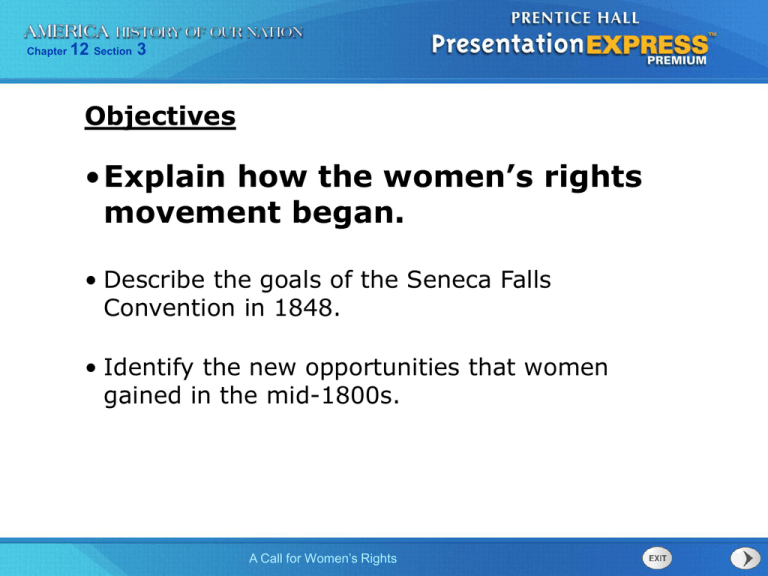
Chapter 12 Section 3 Objectives •Explain how the women’s rights movement began. • Describe the goals of the Seneca Falls Convention in 1848. • Identify the new opportunities that women gained in the mid-1800s. A Call for Women’s Rights Chapter 12 Section 3 Terms and People • Sojourner Truth – a former slave who spoke out for the rights of African Americans and women • Lucretia Mott – a Quaker and an abolitionist with considerable organizing and public speaking skills • Elizabeth Cady Stanton – an abolitionist who was a co-organizer of the Seneca Falls Convention for women’s rights; author of the Declaration of Sentiments; co-founder of the National Woman Suffrage Association A Call for Women’s Rights Chapter 12 Section 3 Terms and People (continued) • women’s suffrage – the right of women to vote • women’s rights movement – an organized effort to improve the political, legal, and economic status of women in American society • Susan B. Anthony – a close ally of Stanton’s; co-founder of the National Woman Suffrage Association A Call for Women’s Rights Chapter 12 Section 3 Warm Up Questions 1. List 2 things that women could not do in the mid 1800’s. 2. Sojourner Truth is unique because she was both a former ____________ and part of the ____________ ____________ movement. A Call for Women’s Rights Chapter 12 Section 3 Chapter 12 Section 3: A Call for Women’s Rights Explain how the women’s rights movement began. A Call for Women’s Rights Chapter 12 Section 3 How did the women’s suffrage movement begin? Women participated in abolitionism and other reform efforts. Some women activists also began to focus on equal rights for themselves. A Call for Women’s Rights Chapter 12 Section 3 Most Americans believed that a woman’s place was in the home. Status of Women in the Early 1800s • Women could not vote, hold public office, or serve on juries • Few women received any level of higher education. • Women could not work in most trades or professions. • Women were paid less than men doing the same jobs. • Married women lost legal control of any money or property they owned before marriage to their husbands. A Call for Women’s Rights Chapter 12 Section 3 Women who were active in social reform movements believed that they could make valuable contributions to American society. Sojourner Truth was one of these women. She inspired the large crowds who came to hear her speak in favor of political rights for women and enslaved African Americans. A Call for Women’s Rights Chapter 12 Section 3 Lucretia Mott was a Quaker and an abolitionist who had considerable organizing and public speaking skills. In 1840, Mott traveled to London to attend an international antislavery convention. A Call for Women’s Rights Chapter 12 Section 3 There, she met another abolitionist, Elizabeth Cady Stanton. Mott and Stanton were told that women could not take an active role in the London convention. Furious, they decided to hold a convention to advance women’s rights. A Call for Women’s Rights Chapter 12 Section 3 The Seneca Falls Convention Time + Place • Summer of 1848 • Seneca Falls, New York Purpose • To advance the Women’s rights movement Participants • More than 300 women and men attended. Declaration of Sentiments • Stanton wrote a Declaration of Sentiments which demanded full equality for women in every area of life. • Stanton’s argument was the beginning of the long battle for women’s suffrage. A Call for Women’s Rights Chapter 12 Section 3 Question: Why was the Seneca Falls Convention so important? A Call for Women’s Rights Chapter 12 Section 3 The first student to get the CORRECT answer to the following question and who does not call out gets an extra credit point: What name is listed on this roster that we more commonly associate with the abolitionist movement? Hint: Look under gentlemen. A Call for Women’s Rights Chapter 12 Section 3 Answer: Frederick Douglass A Call for Women’s Rights Chapter 12 Section 3 Not everyone wanted to include women’s suffrage in the Declaration of Sentiments, but in the end the convention voted to include it. In 1869, Stanton and Susan B. Anthony founded the National Woman Suffrage Association. A Call for Women’s Rights Chapter 12 Section 3 However, the women’s rights movement did win some victories in the nineteenth century: Women did not win the vote nationally until 1920. • In 1860, New York passed a law protecting women’s property rights, and many other states followed. • Some states gave married women the right to keep their wages. A Call for Women’s Rights Chapter 12 Section 3 In the early 1800s, women were seldom given the opportunity to study advanced subjects like math and science. The women’s rights movement focused much attention on education for girls and women. Even before the Seneca Falls Convention, reformers worked to give girls opportunities for better education. A Call for Women’s Rights Chapter 12 Section 3 Education for Girls and Women The Troy Female Seminary • In 1821, Emma Willard opened an academy in Troy, New York. • It soon became the model for girls’ schools everywhere. • Many female reformers of this era attended Willard’s school. Mount Holyoke Female Seminary • In 1837, Mary Lyon opened the first college for women in the United States. • Mount Holyoke showed that women could learn advanced subjects such as Latin, geometry, and chemistry. A Call for Women’s Rights Chapter 12 Section 3 American society came to accept that girls could be educated and that women could be teachers. A Call for Women’s Rights More schools began hiring women teachers who had been trained at one of the new schools for women. Chapter 12 Section 3 Causes of the Women’s Rights Movement Effects • Women lacked many of the rights had by men. • Suffragists demanded that women have the right to vote. • Many abolitionists believed that women also deserved equal rights. • States passed laws to protect women’s property rights. • The Seneca Falls Convention launched the women’s rights movement. A Call for Women’s Rights • Private schools for women were opened; some colleges accepted women. • Women entered careers once closed to them. Chapter 12 Section 3 How would you say the following quote in your own words? “The fact is, women are in chains, and their servitude is all the more debasing because they do not realize it.” – Susan B. Anthony Servitude - The state of being a slave or completely subject to someone more powerful. Debasing – to lower in esteem, or character, to degrade A Call for Women’s Rights Chapter 12 Section 3 Closing Questions: 1. Identify one other movement besides the Women’s Rights Movement that women participated in. 2. The Declaration of Sentiments is the first document which called for what? 3. What was the first profession that women entered in mass? 4. In two complete sentences explain how the Women’s Rights Movement began. 5. What were some of the overall goals of the Women’s Rights Movement? When finished work on your chapter 12 graphic organizer. A Call for Women’s Rights Chapter 12 Section 3 Section Review QuickTake Quiz A Call for Women’s Rights Know It, Show It Quiz
